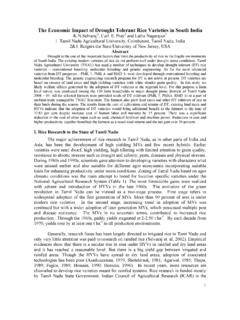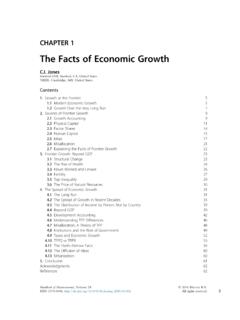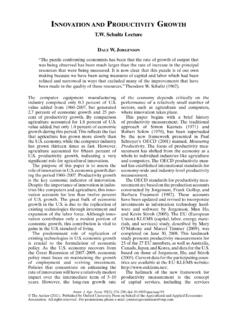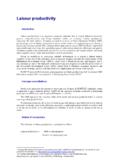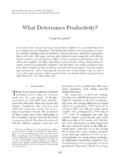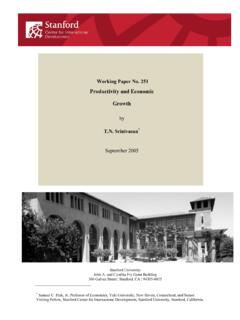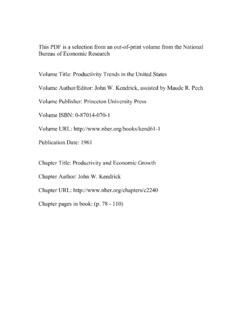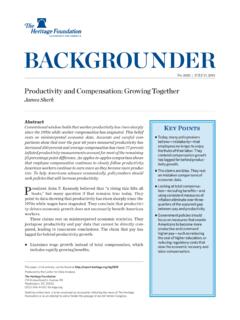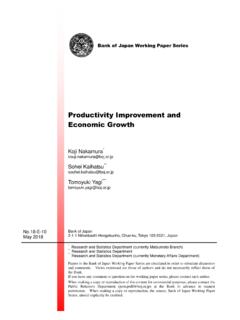Transcription of Agricultural Production and Economic Growth in Nigeria ...
1 Quarterly Journal of International Agriculture 53 (2014), No. 3: 207-223 Quarterly Journal of International Agriculture 53 (2014), No. 3; DLG-Verlag Frankfurt/M. Agricultural Production and Economic Growth in Nigeria : Implication for Rural Poverty Alleviation Oyinbo Oyakhilomen and Rekwot Grace Zibah Ahmadu Bello University, Zaria, Nigeria Abstract This research was carried out to provide empirical information on the relationship between Agricultural Production and the Growth of Nigerian economy with focus on poverty reduction. Time series data were employed in this research and the analyses of the data were done using unit root tests and the bounds (ARDL) testing approach to cointegration. The result of the data analysis indicated that Agricultural Production was significant in influencing the favourable trend of Economic Growth in Nigeria . Despite the Growth of the Nigerian economy, poverty is still on the increase and this calls for a shift from monolithic oil-based economy to a more plural one with agriculture being the lead sector.
2 It was recommended that pro poor policies should be designed for alleviating rural poverty through increased investments in Agricultural development by the public and private sector. Keywords: agriculture, cointegration, development, Economic Growth , poverty JEL: E31, O11, O47, O55, Q10 1 Introduction With 75% of the world s poor in rural areas and most of them dependent on farming, agriculture must be part of world Economic Growth , poverty reduction, and environ-mental sustainability (UNDP, 2012). Agriculture is critical to achieving global poverty reduction targets and it is still the single most important productive sector in most low-income countries, often in terms of its share of Gross Domestic Product and almost always in terms of the number of people it employs (IDA, 2009). In countries where the share of agriculture in overall employment is large, broad-based Growth in agri-cultural incomes is essential to stimulate Growth in the overall economy, including the non-farm sectors selling to rural people.
3 Hence, the ability of agriculture to generate overall GDP Growth and its comparative advantage in reducing poverty will vary from country to country (FAO, 2012). The majority of the poor and food insecure in Africa live in rural areas, and most of them depend on agriculture for their livelihoods. To support broad-based poverty reduction and food security in Africa, smallholder agri-culture must be a central investment focus (GARVELINK et al., 2012). The sheer size of 208 Oyinbo Oyakhilomen and Rekwot Grace Zibah Quarterly Journal of International Agriculture 53 (2014), No. 3; DLG-Verlag Frankfurt/M. agriculture in most African economies suggests that strategies designed to promote the early stages of Economic Growth cannot ignore agriculture. The promotion of the rural economy in a sustainable way has the potential of increasing employment opportunities in rural areas, reducing regional income disparities, stemming pre-mature rural-urban migration, and ultimately reducing poverty at its very source (ANR QUEZ and STAMOULIS, 2007).
4 The potential of agriculture to generate a more pro-poor Growth process depends on the creation of new market opportunities that most benefit the rural poor (HANJRA and CULAS, 2011). Nigeria is a vast Agricultural country endowed with substantial natural resources which include: 68 million hectares of arable land; fresh water resources covering about 12 million hectares, 960 kilometres of coastline and an ecological diversity which enables the country to produce a wide variety of crops and livestock, forestry and fisheries products (AROKOYO, 2012). Poverty in Nigeria is concentrated in rural areas, which are home to more than 70% of the nation s poor. Development indicators for rural areas lag behind those for urban areas: incomes are lower, infant mortality rates are higher, life expectancy is shorter, illiteracy is more widespread, malnutrition is more prevalent, and greater proportions of people lack access to clean water and improved sanitation services (TSIGAS and EHUI, 2006).
5 One sector that has a critical role to play in poverty reduction in Nigeria is the agri-culture sector as over 40% of the GDP comes from the sector and it employs about 60% of the working population (NWAFOR et al., 2011). However, the agriculture sector has the highest poverty incidence and tackling poverty entails tackling Agricultural underdevelopment. Economic Growth in Nigeria has largely been accounted for by resilient Agricultural Growth associated with performance in four constituent sub-sectors: crops, livestock, fisheries and forestry (EBOH et al., 2012). While the Agricultural sector may have in recent years contributed significantly to improved Growth performance in Nigeria , its actual contribution appears to be much short of overall potential. Although several studies have outlined the theoretical relationship between agriculture and Economic Growth , disagreements still persist (AWOKUSE, 2009). The causal dynamics between agriculture and Economic Growth is an empirical question worthy of further investigation.
6 As TIMMER (2005) noted, part of the controversy of the role of agri-culture in development stems from the fact that structural transformation is a general equilibrium process that cannot be explained by looking at agriculture alone. The issue of how and under what conditions agriculture is a driving force of rural Growth has received scant attention or has given mixed messages including in the position of major multilateral financing institutions (ANRIQUEZ et al., 2003). Despite the myriads of existing literature on the between agriculture and Economic Growth across the globe and in particular sub-Saharan Africa, there exists a relative dearth of empirical information on the relationship between agriculture and Economic Growth in Nigeria with a bigger picture on rural poverty. Therefore, this research was designed to fill the Agricultural Production and Economic Growth in Nigeria 209 Quarterly Journal of International Agriculture 53 (2014), No.
7 3; DLG-Verlag Frankfurt/M. existing research gap by providing empirical information on agriculture- Economic Growth nexus and its implication for poverty reduction. 2 Literature Review Agriculture and Economic Growth Linkages Scholarly literature exists on the relationship between agriculture and Economic Growth (JOHNSTON and MELLOR, 1961; THORBECKE and JUNG, 1996; DATT and RAVALLION, 1998; IRZ et al., 2001; GOLLIN et al., 2002; TIMMER, 2002; THIRTLE et al., 2003; TIFFIN and IRZ, 2006; SANDRI et al., 2007; WORLD BANK, 2008). Growth in Agricultural output can fuel Growth in the non- Agricultural economy through a variety of mechanisms, some direct and some indirect. Previous studies have concentrated on market-based inter-sectoral linkages as the source of agriculture's contribution to Economic Growth . JOHNSTON and MELLOR (1961) observe that agriculture contributes to Economic Growth and development through five inter-sectoral linkages.
8 The sectors are linked via: (i) supply of surplus labor to firms in the industrial sector; (ii) supply of food for domestic consumption; (iii) provision of market for industrial output; (iv) supply of domestic savings for industrial investment; and (v) supply of foreign exchange from Agricultural export earnings to finance import of intermediate and capital goods. BLOCK and TIMMER (1994) added a short list of non-market based inter-sectoral linkages through which agriculture contributes indirectly to Economic Growth . These linkages arise from governmental learning by doing, increased Economic stability, food security, and the relative efficiency of rural household decision-making. TIMMER (1995) also emphasized the importance of indirect non-market linkages that improves the quality of the major Production factors (labor and capital). He observes that agriculture indirectly contributes to Economic Growth via its provision of better caloric nutrient intake by the poor, food availability, food price stability, and poverty reduction.
9 He argued that the role of agriculture has been underestimated because of data limitations that preclude explicit quantitative analyses of the indirect effects of agriculture s contributions to capital and labor efficiency and total factor productivity . However, agriculture is not always a panacea for Economic development and poverty reduction. A country which relies on Agricultural export can be adversely affected by global Economic shocks (CUONG, 2009). Despite urbanisation, Africa is still a pre-dominantly rural continent, with more than 60% of 906 million persons living in rural areas in 2005; where most households live in villages and farm, even if they undertake other activities for their livelihoods as well (WIGGINS, 2009). Although Sub-Saharan Africa experienced unprecedented Economic Growth in recent decades, this did not always translate into less poverty or improved nutrition (PAUW and THURLOW, 2011).
10 210 Oyinbo Oyakhilomen and Rekwot Grace Zibah Quarterly Journal of International Agriculture 53 (2014), No. 3; DLG-Verlag Frankfurt/M. Higher Agricultural productivity is vital for Economic Growth , especially in Africa, because of strong Growth linkages and comparative advantages in trade. Higher Agricultural productivity can deliver a triple dividend; sustained food security, higher human development and lower pressure on land and water (UNDP, 2012). Agriculture and Poverty Linkages Globally, extreme poverty continues to be a rural phenomenon despite increasing urbanization. Of the world s billion extremely poor people, 75% live in rural areas and for the most part they depend on agriculture, forestry, fisheries and related activities for survival (ANR QUEZ and STAMOULIS, 2007). World Agricultural productivity , particularly in poor countries, is key to global food security and the fight against hunger and poverty (VON BRAUN et al.)


